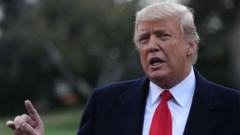Executive actions signal a potential resurgence in the nuclear energy sector with new, streamlined procedures.
**Nuclear Renaissance: New Executive Orders Aim to Expedite Reactor Development**

**Nuclear Renaissance: New Executive Orders Aim to Expedite Reactor Development**
The Trump Administration pushes for rapid nuclear power plant approvals amid energy demands.
In a bold move to reinvigorate the American nuclear power landscape, President Trump issued four executive orders last Friday, aimed at accelerating the construction of new nuclear reactors, including innovative small-scale facilities. These directives compel the Nuclear Regulatory Commission (NRC), the agency responsible for overseeing nuclear safety, to expedite the approval process for new reactor applications to a maximum of 18 months.
Furthermore, one of the orders tasks the Energy and Defense departments with investigating the feasibility of situating reactors on federal properties and military installations, potentially allowing for a more nimble approval process that bypasses the NRC’s traditional regulatory frameworks.
"This marks a significant day for the nuclear sector," declared Interior Secretary Doug Burgum during the Oval Office signing ceremony. "This day should be marked as a turning point against overregulation that has stifled our energy strategies for over half a century."
The urgency of these actions coincides with Trump's declaration of a “national energy emergency,” citing insufficient energy availability to support the burgeoning demands of artificial intelligence data centers. While the administration has predominantly championed fossil fuel investments, it acknowledges the pivotal role of nuclear power in meeting energy requirements without generating carbon emissions.
Nuclear power appears to be gaining traction across political lines, with bipartisan support in Congress. Nonetheless, concerns regarding safety regulations and nuclear waste disposal persist among some Democrats. Conversely, many Republicans advocate for nuclear energy, emphasizing its reliability as a consistent power source compared to intermittent renewables such as wind and solar.
As the U.S. grapples with its energy future and the complexities of climate change, these new measures may play a vital role in reshaping the nation's energy policies and contribute significantly to reducing greenhouse gas emissions.
Furthermore, one of the orders tasks the Energy and Defense departments with investigating the feasibility of situating reactors on federal properties and military installations, potentially allowing for a more nimble approval process that bypasses the NRC’s traditional regulatory frameworks.
"This marks a significant day for the nuclear sector," declared Interior Secretary Doug Burgum during the Oval Office signing ceremony. "This day should be marked as a turning point against overregulation that has stifled our energy strategies for over half a century."
The urgency of these actions coincides with Trump's declaration of a “national energy emergency,” citing insufficient energy availability to support the burgeoning demands of artificial intelligence data centers. While the administration has predominantly championed fossil fuel investments, it acknowledges the pivotal role of nuclear power in meeting energy requirements without generating carbon emissions.
Nuclear power appears to be gaining traction across political lines, with bipartisan support in Congress. Nonetheless, concerns regarding safety regulations and nuclear waste disposal persist among some Democrats. Conversely, many Republicans advocate for nuclear energy, emphasizing its reliability as a consistent power source compared to intermittent renewables such as wind and solar.
As the U.S. grapples with its energy future and the complexities of climate change, these new measures may play a vital role in reshaping the nation's energy policies and contribute significantly to reducing greenhouse gas emissions.























